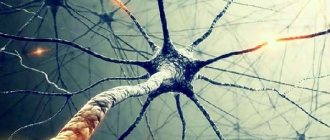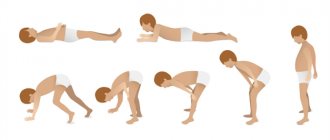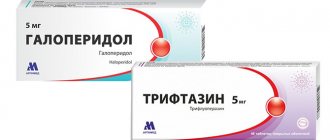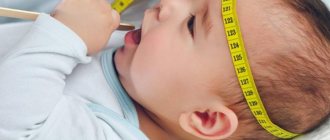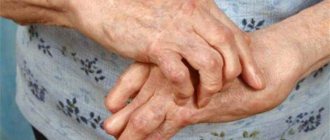2310
0
—>
Most often, manic syndrome begins to manifest itself in men and women during a period when there is a periodic phase of exacerbation of the disease under the influence of stressful situations or seasonal relapses. Manic-depressive syndrome occurs in the form of attacks, when the patient behaves quite adequately, maintains a conversation, reacts quite typically to life circumstances and external stimuli, and then within a few minutes directly changes his psycho-emotional state. Symptoms and signs of manic-depressive psychosis are always pronounced. The patient becomes violent, increased hand motor skills are noted, the thinking process accelerates and, accordingly, speech becomes more dynamic.
A person suffering from this form of mental illness may start several things at once and not complete any of them. At the same time, most patients accompany their actions with active facial expressions and commentary on the work process. The disease is considered dangerous both for the sick person and for the people around him, as it is a borderline state and the first step towards the development of a schizophrenic disorder.
Until 1993, the disease was called exclusively manic-depressive psychosis, and then changes were made to the international classification of mental illnesses, and the pathology was officially renamed bipolar affective disorder.
The need to change the terminology was justified by the fact that the symptoms of the disease are not
completely corresponds to the old definition, since patients do not always experience psychosis, and those around them, because of the name of the disease, begin to be prejudiced towards such people. Psychiatrists provide treatment for MDP.
About the disease
Manic depressive psychosis (symptoms and signs are discussed below) has another name - manic depression. To date, this is one of the most studied affective personality disorders in medicine. The disease occurs in two phases, between which there are periods (intermissions) when the symptoms of the disorder completely disappear and the person seems to be absolutely normal. Sometimes the disease is called bipolar affective disorder, but this term characterizes only one of the phases of the disease itself.
Prerequisites
There is no exact data on how many people on the planet suffer from this disorder. Doctors who admit patients to hospital for treatment know that the number of people admitted with this disease is approximately 3-5%. MDP is characterized by two peak periods. The first of them can occur in a person aged 20-30 years. The second finds a person in menopause. Seasonality is also pronounced. This means that the patient's condition changes over the course of the year. In spring and autumn, symptoms are usually more pronounced. Strong mood swings also occur during the day. In the morning a person feels very bad, but in the evening he calms down a little.
The course of manic-depressive psychosis is individual for everyone, but the causes may be the same. Doctors believe that the disease can be inherited. Repeated studies have shown that if someone in the family has suffered from any affective personality disorder, then there is a high probability that the child will be predisposed to the disease. This fact can be confirmed by multiple studies regarding the transmission of the disease between identical twins. If one of them fell ill, then over time the second also began to experience symptoms of the disorder. At the same time, you can fall into a risk group for various reasons. Experts believe that the constitution of the body and the functioning of the human endocrine system can influence susceptibility to affective disorder. For women, the trigger can be childbirth and the onset of menopause. Thus, we can conclude that the reasons lie in human biology, and not mental deformity.
Classification
2 main groups of the disease:
Endogenous psychosis caused by internal factors (disorder of the functioning of the nervous and endocrine systems).
- Exogenous, caused by external factors (infections, intoxication, nervous strain, mental trauma).
Depending on appearance:
- Acute: develops instantly.
- Reactive: formed due to prolonged exposure to mental trauma.
In addition, according to etiology and pathogenesis, the following forms of the disease are distinguished:
- Alcoholic;
- Amphetamine psychosis;
- Hypomanic psychosis;
- Hysterical;
- Korsakovsky;
- Senile;
- Involutionary;
- Paranoid;
- Schizoaffective;
- Postpartum.
Diagnosis of manic-depressive psychosis
To detect the disease, a person must have at least two attacks. One of them must be manic. Making a diagnosis is a long and difficult period during which the doctor collects information about heredity and recent shocks that could cause an affective disorder. In some situations, it may be necessary to monitor the patient for a long time to understand the causes. To make a correct diagnosis, it is very important to make sure that physiological causes, such as malfunctions of the thyroid gland, are not contributing to the disease. This means that it is necessary to carry out a differential diagnosis. Recently, doctors have been paying more and more attention to such factors as drug use. Very often, it is under their influence that a person develops a personality disorder.
Manic-depressive psychosis: causes
The root cause of manic-depressive disorder lies in the disruption of the higher emotional centers in the subcortical region of the brain. Experts believe that so far the most common cause is heredity, that is, a genetic factor. In some cases, a child receives this pathology from his mother. Recently, a new theory has emerged in medicine, according to which a separate gene is responsible for each disorder. However, if it were just a matter of genetics, then half the world's population would suffer from these diseases. Moreover, manic-depressive psychosis, the symptoms and signs of which we are considering, would become an epidemic. In some cases, even with a hereditary predisposition, a person remains healthy. Regular stress, an unfavorable social environment, and severe shock can affect the development of the disease. In most cases, the impetus for the development of the disease is the fact of violence.
Signs of psychosis
- Hallucinations: auditory, olfactory, visual, tactile and gustatory. The most common characteristic is the appearance of auditory hallucinations, perceived by patients as a voice inside the head or from outside.
- Crazy ideas. They include judgments and conclusions that are not true. The patient is completely captivated by these ideas, and it is impossible to prove or convince him.
The most common delusions of persecution (surveillance), negative influence (aliens, KGB), delusions of causing damage (theft, poison in food, survival from home). Sometimes delusions of grandeur, illness, jealousy and others may occur.
- Movement disorders. It may manifest itself as stupor, in which the patient remains in one position for a long time, and inactivity. He does not try to answer questions, his gaze is fixed on one point. Or the person is in an excited state: he moves and speaks without stopping, makes a grimace, tries to imitate people and be aggressive and do strange things.
- Mood disorders: being in a depressive or manic state.
As the disease develops, behavioral and emotional reactions change and thinking is impaired.
The patient is unable to correctly perceive reality and may resist hospitalization and treatment.
Symptoms
As we already know, bipolar affective disorder occurs in two phases. Usually one of them predominates. If we talk about the symptoms of the depressive phase, then in this state a person is characterized by a depressed mood and lethargy. He doesn't think well; it takes him a lot of time to understand what they want from him. This is explained by the fact that the patient is completely fixated on his inner world. The events of the outside world cease to be something important for him, because the main goal is to understand himself. However, instead, a person with his thoughts only drives himself into an even greater dead end. In this case, the patient simply needs qualified help. The depressive phase of the disease is dangerous because the patient may fall into complete detachment from the outside world, refuse to eat, or to receive treatment. Often patients harbor plans for suicide.
The manic phase is characterized by the fact that the person is in an overly excited state and mood. He is mentally agitated. Excessive physical activity is also noted. Such a person is unnaturally sociable. He is constantly overwhelmed by thoughts, his mood changes very quickly. The patient looks like an anxious, agitated person. However, a healthy person calms down after a certain period of time, but a patient with affective personality disorder can remain in this state for a very long time.
Depressive phase
We looked at the symptoms of the depressive phase of psychosis, but did not talk about how it occurs. During this period, the patient experiences a very interesting condition. Up to a certain point, anxious thoughts, apathy and indifference increase. However, then there comes a peak, after which all the symptoms very gradually disappear. Recognizing the disease in this case is very difficult, because from the outside it seems that the person is simply sometimes immersed in himself. You can recognize the depressive phase by the fact that a person is absolutely indifferent not only to himself, but also to his loved ones, their joys and anxieties. Moreover, he sees the picture of his future as very gloomy. If you start a topic about future plans, you can hear many hours of reasoning about how there is no future. But entering into a dialogue with the patient is also extremely difficult. Usually he does not make contact, preferring loneliness.
You can almost never see a smile on your face, other than a pitiful or ironic grin. If a person has a lot of free time, he can sit in one place for hours and look at one point. At the same time, he will not feel physical discomfort or boredom. Many patients experience strong feelings of guilt. They believe that they are a burden to their relatives. Distinctive features of this phase include insomnia, severe weight loss and loss of appetite.
Preventive measures
There are no ways to prevent psychosis. But, it is important:
- In case of endogenous psychoses, it is important that the patient or his relatives independently monitor the deterioration of the condition and promptly seek help from a doctor. The risk of organic, somatogenic and symptomatic psychoses can be reduced by following a healthy lifestyle and a specially selected therapeutic diet.
- Psychogenic ones are more often observed in asthenized people, so their risk can be reduced, in addition to maintaining a healthy lifestyle, through various strengthening exercises and taking a course of personal growth.
- Prevention of intoxication, withdrawal and post-withdrawal psychoses can be the non-use of toxic substances, avoiding situations of possible drug use or excessive alcohol consumption, as well as promptly seeking medical help in case of poisoning.
Remember that each new psychosis leads to an increase in negative disorders, which are much more difficult to treat than to relieve acute productive symptoms. It is possible and necessary to combat the consequences of psychosis and take preventive measures at home. You can do a lot on your own, but only your psychiatrist has the right to diagnose the current condition, treat with medications and determine preventive doses of pills.
Manic phase
Affective psychoses can be very different in their manifestations. Manic-depressive psychosis is unique in that it is not always possible to understand that a person needs help. In appearance, he seems cheerful and active, maybe a little too much. It is very difficult to keep up with a person’s train of thought. Patients try to constantly attract attention to themselves, sometimes forgetting about decency. Their movements are angular and abrupt. They are always in a hurry and make many mistakes in their activities, some of which can be tragic. Very often such people are active at night, because they hardly need sleep.
Alcohol psychosis: symptoms and treatment
This form is characterized by the following characteristics:
1. Alcohol delirium
This condition is also called “delirium tremens”. Appears 2-7 days after a person stops drinking alcohol. It can last for several hours or days. Characterized by sudden changes in mood, insomnia and psychomotor agitation.
At first, a person feels anxiety, trembling of the head and hands appears. After some time, the consciousness is darkened, frightening hallucinations appear: the appearance of devils, monsters, the sensation of touch, eerie voices. There is a complete violation of topographic and temporal orientation. There are somatic disorders in the form of muscle hypotension, increased sweating, increased body temperature, and tachycardia.
As a rule, delirium ends after a long sleep.
2. Alcoholic hallucinosis
It is most often observed in people over 40 years of age with a total history of alcoholism of about 10 years. It can develop during withdrawal symptoms or in the last day of a long binge.
There are 2 forms of hallucinosis:
Acute: lasts several hours or weeks. The patient feels anxiety and sleep disturbance. The appearance of auditory and sometimes visual hallucinations is characteristic.
A person hears aggressive voices that lead to the development of delusions of persecution and delusions of accusation. He tries to defend himself, hide, and warn his family about the danger.
After a few days, the visions lose their brightness and disappear over time, and the patient loses tension and delusional ideas. The main feature of this form is that the patient does not lose topographical, temporal and personal orientation.
Protracted: it is characterized by the fact that a person is unable to distinguish hallucinations from reality, and they correspond to an everyday situation. Symptoms are dominated by hallucinations, delusions, or movement disorders.
Alcohol paranoid
Characteristic for persons with alcoholism around 12-13 years of age. Due to insomnia, a person is constantly tormented by anxiety, and it is possible to develop acute delusions of persecution.
Such patients are convinced that they can be poisoned or stabbed to death.
Paranoid can be acute and prolonged. In the first form, it appears over several days, less often than weeks, and in the second, it lasts for a long time and lasts for months.
A person often looks healthy, but he becomes overly suspicious, does not trust anyone, and fear and anxiety are present all the time. The patient tries to limit his social circle.
Over time, such people become more and more convinced that they are right, and the nonsense becomes extremely implausible. They are dangerous for loved ones, however, if a person stops drinking, delusional ideas disappear.
Drug therapy
Psychological rehabilitation
A person is taught to perceive the world differently and develop other forms of behavior. Psychotherapy should help him feel comfortable among people and treat himself better, despite his mental illness.
The main element of the events is the participation of groups of people with the same illness. They understand well what it means to be different from everyone else.
Physiotherapy
The following methods are used:
- Electrosleep;
- Spa therapy;
- exercise therapy;
- Acupuncture;
- Occupational therapy.
They help relieve stress, increase performance and improve metabolism.
Electroconvulsive therapy
The basis is the induction of convulsive seizures due to the action of electric current, affecting the subcortical structures of the brain and the metabolism of the nervous system.
The success of therapy largely depends on the time at which treatment measures begin: the earlier treatment begins, the higher the likelihood of curing a mental disorder and preventing negative consequences for the individual.
Treatment
Treatment of manic-depressive psychosis largely depends on the stage of the disease. In the depressive phase, the patient is prescribed antidepressants. Treatment for this phase is very similar to treatment for regular depression. In the manic phase, the patient is prescribed antipsychotics and sedatives. Very often, doctors choose lithium therapy. For quality treatment at any stage of the disease, inpatient observation is desirable. This is due to the fact that a person in a depressive phase can attempt suicide, and a patient in a manic phase can cause harm to others. During periods of intermission, patients can temporarily return to their normal activities. It is worth noting that manic-depressive psychosis (symptoms and signs - in the article) is considered a chronic personality disorder.
What is psychosis?
Psychosis is a mental illness in which a person cannot adequately perceive the surrounding reality and respond to it appropriately. Psychoses are very diverse in their manifestations. They accompany many diseases, such as schizophrenia, senile dementia, delirium tremens, or can be an independent pathology.
In simple terms, during psychosis in a sick person, reality is so distorted in the person’s consciousness that the “picture” before his eyes has nothing to do with reality.
The patient cannot be objective due to fear for his own life, the presence of voices in the head or visions - these internal prisms change a person’s behavior, his reaction becomes unpredictable and inadequate. For example: a person may suddenly laugh or, conversely, start crying out loud.
According to statistics, 15% of patients in mental hospitals are patients with psychosis. And 3-5% of the total population suffer from psychosis caused by various diseases: asthma, cerebral atherosclerosis, etc. But there are still thousands of people whose psychosis is associated with external causes - taking drugs, alcohol, medications. To date, doctors cannot calculate the exact number of patients with psychosis.
- ICD 10 code: F23
Children
It must be said that manic-depressive psychosis in children is very rare. Some doctors are of the opinion that psychosis cannot arise in principle before the age of 10. For children under 14 years of age, a diagnosis is made only if there are pronounced symptoms of depressive and manic phases, the professional opinion of the doctor and his confidence in the correctness of the diagnosis. Inpatient treatment is prescribed only in extreme cases, when the child shows attempts to harm himself or others. In adolescents aged 16-17 years, psychosis is much more common. In terms of its symptoms and course, it is more similar to the “adult” version.
Women
Signs of manic-depressive psychosis in women are not so easy to identify. The fact is that women are more emotional by nature. Very often they are called hysterical, not wanting to notice obvious signs of a possible illness. At a young age, such a disease develops extremely rarely in females. When this occurs, the cause is usually family problems or a history of violence. In this case, the woman needs to consult a psychotherapist immediately, and not brush off the disease. More often, psychosis occurs before or after childbirth. Also, affective disorders can occur at the time of hormonal changes in the body (menopause).
Men
Manic-depressive psychosis occurs 3-4 times less often in men than in women. This is explained quite simply. Since women are more emotional, they experience all situations more deeply and take everything too closely. Men are more persistent by nature, but if something serious unsettles them, they withdraw into themselves instead of trying to analyze and comprehend their condition. When a man withdraws and immerses himself in his own inner world, the first symptoms of the disease may appear. But it is worth understanding that ordinary stress or even severe stress is not enough for the development of manic-depressive psychosis. We have examined its symptoms and signs, and therefore we know that hereditary predisposition plays a very important role. In difficult life situations, a man is more likely to fall into ordinary depression.
Complications and prevention
Ignoring the disease can greatly complicate the situation. The clinical picture of the disease will worsen if the patient refuses or interrupts treatment. It is worth saying that interrupting treatment can be even more dangerous than avoiding it. Abruptly stopping the medication can lead to the opposite effect, when instead of a sedative effect, there will be a stimulating effect. Complications can be very serious. The duration of periods of illness may increase significantly, and the duration of periods of intermission will be reduced. Moreover, if the course of treatment is interrupted, the patient may experience outbursts of aggression, which are very dangerous in the manic phase.
To prevent this disease, follow simple rules. A person must stop using alcohol and drugs. At the same time, it is advisable to learn how to deal with stressful situations correctly. To do this, it will be useful to visit a psychological support group.
Reducing the risk of psychosis relapse
To reduce the risk of exacerbation of a psychotic disorder, you should follow medical recommendations:
- Measured, ordered lifestyle.
- Healthy physical activity, gymnastics.
- A balanced diet and avoiding alcohol and smoking.
- Regular use of prescribed maintenance medications.
Any changes in the usual rhythm of wakefulness and sleep can lead to relapse.
The first signs of relapse: poor appetite, insomnia, irritability. Such signs require examination of the patient by the attending physician.





